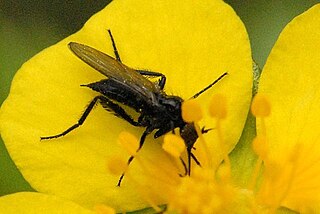
Empis livida is a species of fly in the Empididae family. It is included in the subgenus Kritempis of the genus Empis. Males range from 7.5 to 9.3 millimetres, females 7.5 to 10.2 millimetres. The male's abdomen is brownish and its wings appear faintly brown and clouded. The female's abdomen is gray and its wings are clear. E. livida lives in hedgerows, feeding on the nectar of several species of Rosaceae, several species of Asteraceae, and Heracleum sphondylium nectar; they also feed on other insects. They live all across temperate and Northern Europe, the only species with such a wide distribution. E. livida larvae are also carnivorous and live in damp soil and leaf litter. Adults fly in between April and July.

Empis pennipes is a species of dance flies, in the fly family Empididae. It is included in the subgenus Empis. It is found in most of Europe, except the Balkan Peninsula and the Iberian Peninsula.

Empis planetica is a species of dagger flies, in the fly family Empididae. It is included in the subgenus Empis. It is found in Ireland and Great Britain and from Scandinavia south to Italy.

Empis ciliata, the black dance fly, is a species of dance fly, in the fly family Empididae. It is included in the subgenus Euempis.
Empis hyalipennis is a species of fly in the family Empididae. It is included in the subgenus Coptophlebia of the genus Empis. It is found in the Palearctic.
Empis impennis is a species of fly in the family Empididae. It is included in the subgenus Coptophlebia of the genus Empis. It is found in the Palearctic.
Empis vitripennis is a species of fly in the family Empididae. It is included in the subgenus Coptophlebia of the genus Empis. It is found in the Palearctic.
Empis volucris is a species of fly in the family Empididae. It is included in the subgenus Coptophlebia of the genus Empis. It is found in the Palearctic.
Empis albicans is a species of fly in the family Empididae. It is included in the subgenus Polyblepharis. It is found in the Palearctic.
Empis prodromus is a species of fly in the family Empididae. It is included in the subgenus Empis. It is found in the Palearctic.
Empis pilicornis is a species of fly in the family Empididae. It is included in the subgenus Euempis. It is found in the Palearctic.
Empis semicinerea is a species of fly in the family Empididae. It is included in the subgenus Xanthempis. It is found in the Palearctic.
Empis lamellimmanis is a species of fly in the family Empididae. It is included in the subgenus Leptempis. It is found in the Palearctic.
Empis multispina is a species of fly in the family Empididae. It is included in the subgenus Leptempis. It is found in the Palearctic.
Empis sinuosa is a species of fly in the family Empididae. It is included in the subgenus Leptempis. It is found in the Palearctic.
Empis trunca is a species of fly in the family Empididae. It is included in the subgenus Leptempis. It is found in the Palearctic.
Empis liosoma is a species of fly in the family Empididae. It is included in the subgenus Lissempis of the genus Empis. It is found in the Palearctic.
Empis loewiana is a species of fly in the family Empididae. It is included in the subgenus Xanthempis. It is found in the Palearctic.
Empis scotica is a species of fly in the family Empididae. It is included in the subgenus Pachymeria of the genus Empis. It is found in the Palearctic.
Empis bazini is a species of fly in the family Empididae. It is included in the subgenus Rhadinempis of the genus Empis. It is found in the Palearctic.



